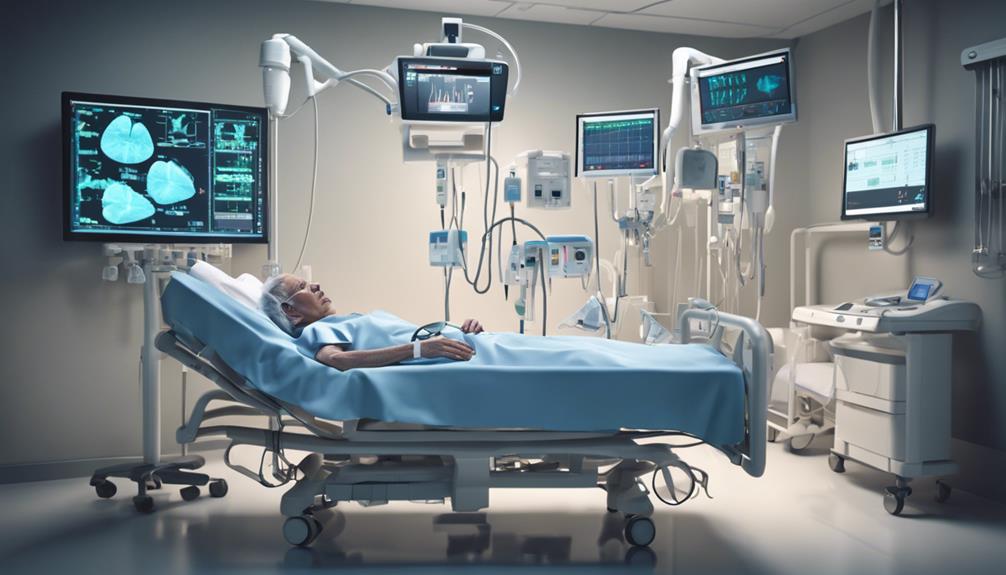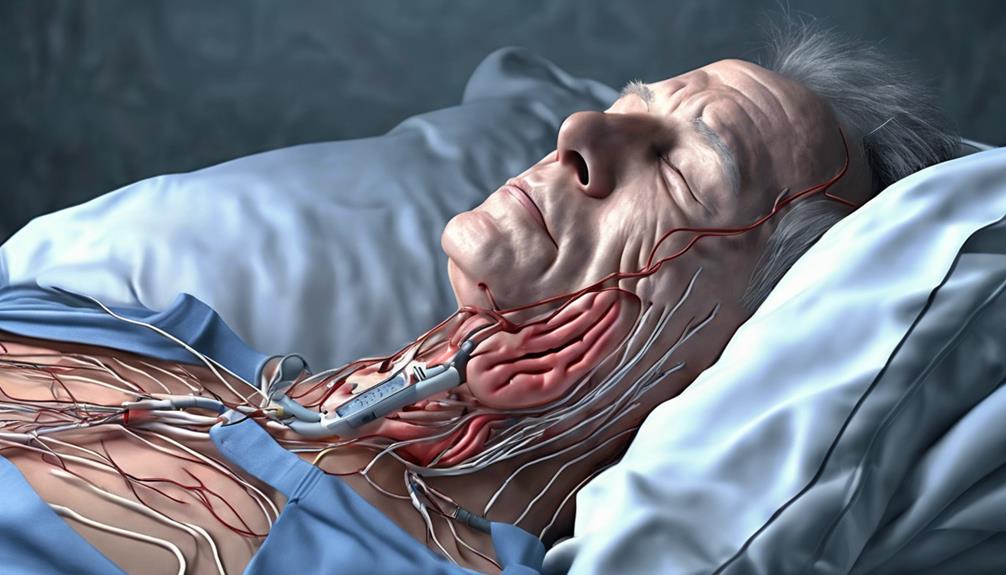Yes, heart rate can increase at the end of life. Changes in heart rate, including increases, can occur as the body progresses towards death. Factors like pain, anxiety, and medications can influence heart rate. Monitoring heart rate is vital in understanding a person’s physiological condition during the terminal stage. By recognizing these variations, caregivers can provide better end-of-life care. Understanding heart rate patterns near death is important for offering appropriate support and comfort. Managing high heart rate in dying patients involves focusing on comfort and symptom management. Prognostic value of heart rate trends helps in adjusting care. Discover more insights on heart rate fluctuations at the end of life.
Key Takeaways
- Heart rate can increase at end of life due to discomfort or distress.
- It is a physiological response during the body's shutdown process.
- Managing with medications like morphine or Ativan ensures patient comfort.
- Focus on comfort rather than correcting rapid heart rate is crucial.
- Recognizing natural processes is vital for compassionate end-of-life care.
Heart Rate Changes in Terminal Stage
In the terminal stage of life, heart rate fluctuations can manifest as increases, decreases, or stability, with tachycardia serving as a common physiological response as the body moves towards the end of life. These changes in heart rate are critical indicators of the dying process. Abnormal vital signs, including fluctuations in heart rate, can often signal the body's progression towards death. It's essential to recognize that these variations in heart rate near death are natural responses as the body prepares for the final shift.
Understanding how heart rate changes as someone nears death is essential for providing appropriate care and support. Monitoring these changes can offer valuable insights into the physiological condition of a person in the terminal stage of life. Recognizing the significance of abnormal vital signs, such as fluctuations in heart rate, can help healthcare providers offer comfort and relief to those at the end of life. By observing and interpreting these signs accurately, we can make certain that individuals receive the care they need during this critical time.
Factors Influencing Heart Rate Variations
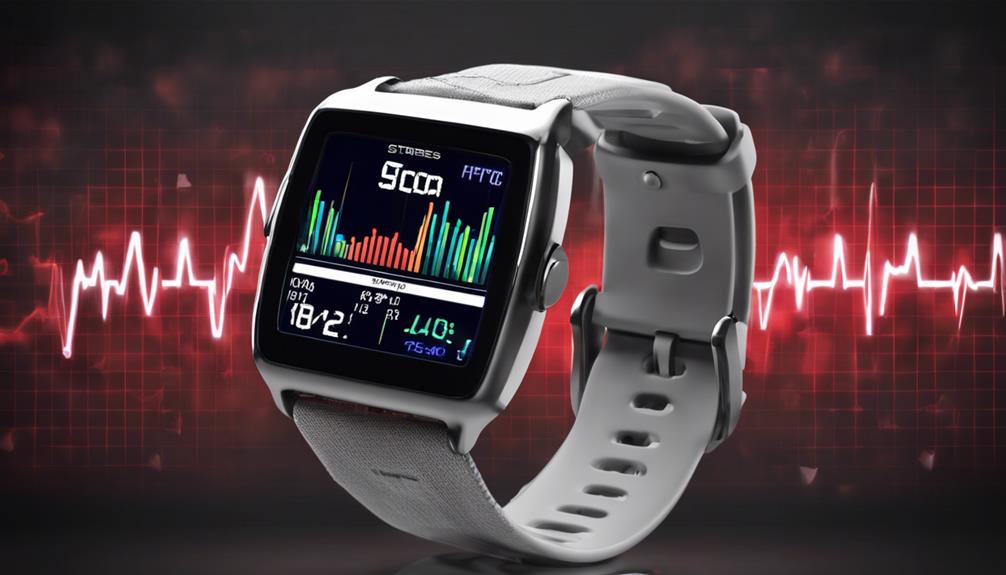
As we investigate the factors influencing variations in heart rate, it becomes evident that understanding the underlying causes is vital for providing the best end-of-life care.
In caring for patients nearing the end of life, it's essential to recognize that various factors can influence heart rate fluctuations during the dying process. Pain, anxiety, and medications administered for comfort can all contribute to an increase in heart rate as the body's physiological stressors respond to the approaching end of life.
Additionally, dehydration and imbalances in electrolytes play a significant role in impacting heart rate in the final stages of life. Monitoring these variations in heart rate near death can offer valuable insights into a patient's comfort and physiological status, ultimately aiding healthcare providers in ensuring the patient's well-being during this sensitive time.
Monitoring Heart Rate in End-of-Life Care
Monitoring heart rate in end-of-life care provides crucial insights into the patient's physiological response and comfort level during this sensitive period. By observing changes in heart rate, healthcare providers can better understand the patient's condition and tailor interventions to guarantee excellent care.
Monitoring heart rate is a pivotal aspect of end-of-life care as it helps in evaluating the patient's well-being and response to treatment. This monitoring allows us to identify signs of distress, such as tachycardia, which may indicate the need for symptom management and additional support.
Not only does it benefit the patient directly, but it also provides valuable information for the family, offering them reassurance and understanding during this challenging time. By closely monitoring heart rate trends, healthcare providers can offer compassionate care that addresses the patient's needs and promotes comfort.
Effective monitoring of heart rate in end-of-life care is a vital component of providing holistic and supportive care to both the patient and their family.
Heart Rate Patterns Near Death
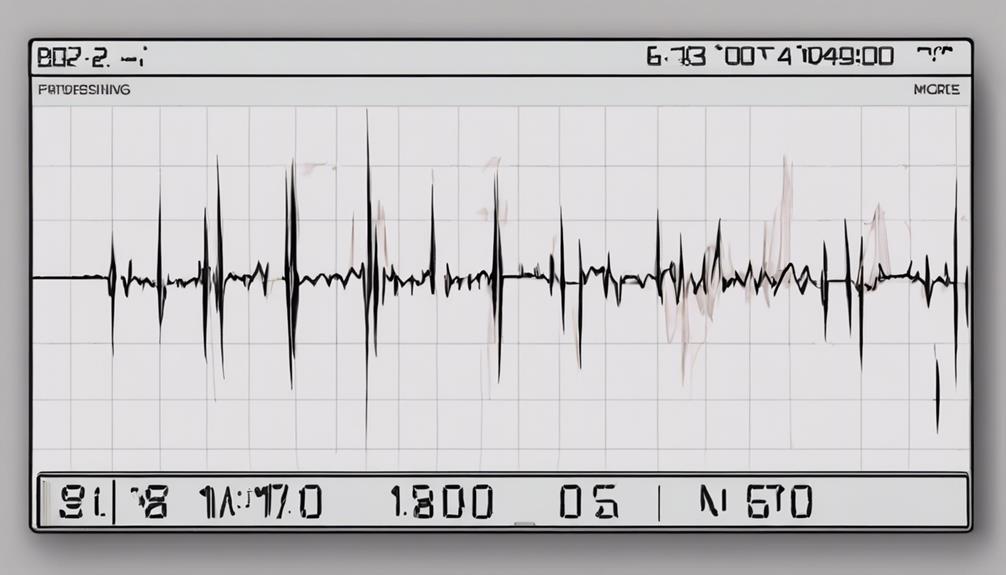
Examining heart rate patterns near death offers valuable insights into the body's physiological changes as it nears the end of life. As individuals approach the end of life, their heart rate can exhibit various patterns. Here is a table outlining some common heart rate patterns observed near death:
| Heart Rate Pattern | Description |
|---|---|
| Increased | Heart rate rises above normal levels, indicating the body's response to the imminent death. |
| Decreased | Heart rate drops below normal, signaling the body's decline towards the end of life. |
| Irregular | Heart rate fluctuations occur, reflecting the body's struggle as it nears the end. |
| Stable | Heart rate remains constant, suggesting a smooth progression towards the final moments. |
Understanding these heart rate patterns is essential in providing the best end-of-life care. By recognizing these changes, caregivers can offer appropriate support and comfort tailored to the individual's needs. Paying attention to heart rate variations can enhance the quality of care provided during this delicate stage of life.
Understanding Terminal Heart Rate Increase
Let's discuss why the heart rate might go up as someone nears the end of their life.
This increase in heart rate could be a sign that the person is feeling discomfort or distress.
Understanding what causes this rise can help healthcare providers better manage a patient's symptoms and guarantee their comfort.
Terminal Heart Rate Significance
As we observe a terminal heart rate increase in dying patients, it's important to recognize that this physiological response is often a natural part of the body's shutdown process. During the dying process, the heart rate can rise, which may indicate distress or discomfort.
This increase in heart rate can be managed with appropriate medications like morphine or Ativan to guarantee the patient's comfort. Dehydration, common in the dying phase, may lead to elevated calcium levels, inducing sleep and eventual death.
Healthcare providers should focus on maintaining the patient's comfort rather than trying to correct the rapid heart rate in the terminal phase. Understanding these natural processes is essential for providing compassionate end-of-life care when observing an increase in heart rate.
Causes of Increase
When considering the reasons behind the increase in heart rate at the end of life, it becomes evident that this physiological response is often a sign of the body's natural adjustment during the dying process.
Factors contributing to the terminal heart rate increase include dehydration, pain, or distress in the dying person.
Monitoring the heart rate increase can help in providing comfort to the individual.
Addressing the elevated heart rate is essential for effective symptom management during the end-of-life stage.
Understanding these causes allows healthcare providers to focus on enhancing the comfort and well-being of the dying person through attentive symptom management. By recognizing and addressing these factors, we can ensure a more peaceful and dignified passage for individuals nearing the end of life.
Clinical Implications Explained
Understanding the clinical implications of terminal heart rate increase is essential for providing best end-of-life care to patients in their final stages.
Terminal heart rate increase, a natural part of the dying process, may signal discomfort, necessitating the use of comfort-focused medications such as morphine or Ativan.
Dehydration, commonly seen in the dying process, can lead to elevated calcium levels, inducing sleep and eventual passing, contributing to the rise in heart rate.
It's vital for healthcare providers to prioritize the patient's comfort over attempting to interfere with the natural progression of dying.
Clinical Implications of Elevated Heart Rate

Elevated heart rate in patients nearing the end of life can have significant clinical implications.
It may impact the prognosis, influence treatment considerations, and necessitate close monitoring of heart health.
Understanding these implications is vital for healthcare providers to provide appropriate care and guarantee the comfort of patients in their final stages.
Impact on Prognosis
In the clinical setting, a high heart rate near the end of life serves as an important indicator of the patient's physiological response during the dying process. Monitoring these changes can give us valuable insights into the individual's comfort levels, indicating the need for symptom management. When heart rate elevates towards the end of life, it may suggest the necessity for palliative interventions to guarantee a peaceful passing.
- Understanding the patient's comfort levels
- Providing appropriate symptom management
- Offering palliative interventions for a peaceful passing
Treatment Considerations
To address the clinical implications of an elevated heart rate near the end of life, we prioritize symptom management and palliative interventions to guarantee patient comfort and a peaceful passage. In patients with advanced cancer, Palliative Care plays an important role in addressing the physical, emotional, and spiritual needs of individuals nearing the end of life.
Monitoring Heart Health
As we focus on monitoring heart health in individuals approaching the end of life, attention to changes in heart rate becomes essential for evaluating their comfort and symptom management needs.
- Regularly assess heart rate to gauge distress levels and the effectiveness of symptom management.
- Consult healthcare providers for guidance on managing elevated heart rates in end-of-life care.
- Consider medication options such as morphine or Ativan to help regulate heart rate and improve comfort levels.
Monitoring heart rate is a vital aspect of providing quality end-of-life care. By staying vigilant and responsive to changes in heart rate, healthcare providers can better address the needs of individuals in their final stages of life, ensuring comfort and symptom control are optimized.
Managing High Heart Rate in Dying Patients
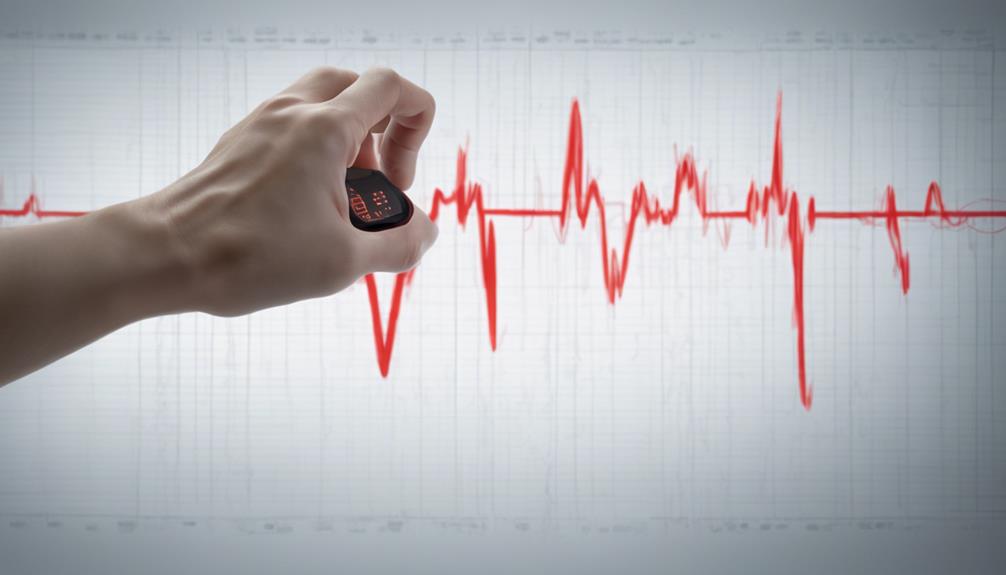
High heart rate in dying patients necessitates prompt intervention with appropriate medications like morphine or Ativan to alleviate distress and guarantee comfort. When a dying individual experiences a high heart rate, it may signal underlying distress or discomfort.
As part of compassionate care during the end-of-life process, healthcare providers focus on managing symptoms rather than attempting to cure the condition. Dehydration, commonly seen in dying patients, can contribute to an elevated heart rate as the body prepares for closure, leading eventually to a peaceful passing.
Understanding these natural responses and changes in heart rate is crucial for providing comfort and support in the final stages of life. By administering medications like morphine or Ativan, healthcare professionals can help ease the distress associated with a high heart rate, allowing the patient to rest more comfortably as they move towards the end of life. In addition to managing heart rate, addressing other factors such as respiratory distress is important for enhancing patient comfort. Understanding the causes of sleep apnea is essential, as compromised breathing can further exacerbate discomfort in end-of-life care. By recognizing and treating these conditions, healthcare providers can ensure a more peaceful and dignified transition.
Prioritizing the comfort and well-being of the dying individual is essential in providing quality care during this sensitive time.
Heart Rate Fluctuations in Final Days
Understanding the nature of heart rate fluctuations during the final days of life is essential for providing excellent end-of-life care. In the dying process, the heart rate can exhibit various patterns that can offer insights into the patient's condition and comfort. Here are some key points to take into account:
- Stable Heart Rate: In many cases, the heart rate tends to remain steady as a person nears the end of life. This stability can indicate a level of comfort and peace.
- Tachycardia Signaling Distress: Rapid heart rate, known as tachycardia, towards the end of life may suggest that the individual is in distress and requires additional symptom management to enhance their comfort.
- Natural Response to Dying Process: Changes in heart rate can be a natural part of the body's response to the dying process. Understanding these fluctuations is vital for delivering appropriate end-of-life care that prioritizes the patient's well-being and dignity.
Prognostic Value of Heart Rate Trends
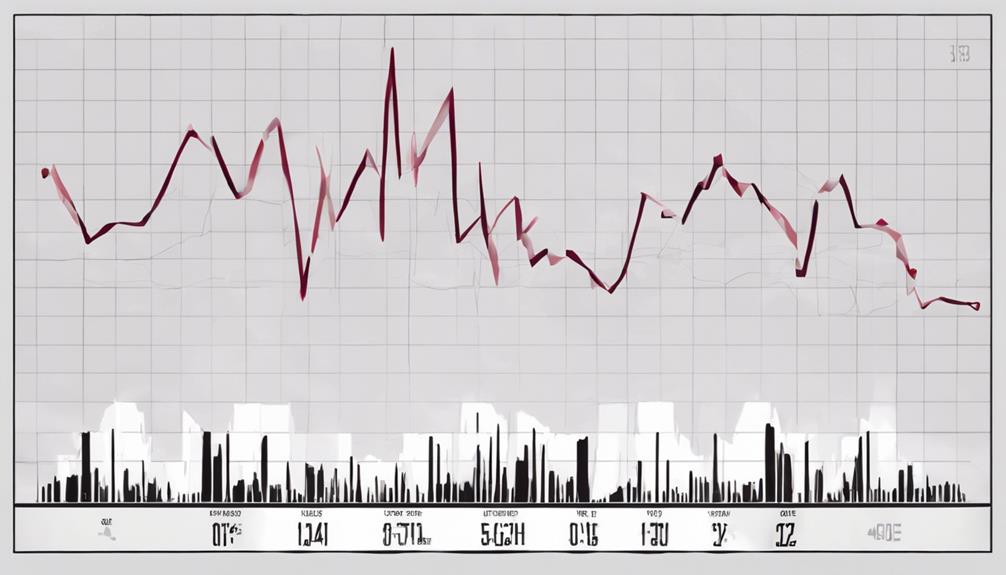
Heart rate patterns can offer vital insights into the progression towards the end of life.
By monitoring changes in heart rate, healthcare providers can gather valuable information about a patient's condition.
Understanding these patterns may help predict when a patient is approaching the final stages of life.
Heart Rate Patterns
During the terminal phase of life, observing the trends in heart rate can provide essential insights into the patient's condition and prognosis. Understanding heart rate patterns is pivotal for symptom management and ensuring comfort for those nearing the end of life.
Here are key points to contemplate:
- Heart rate fluctuations can indicate distress or pain in the dying individual.
- Sudden spikes in heart rate may signal a deterioration in the patient's health.
- Monitoring changes in heart rate trends can help healthcare providers anticipate impending death and adjust care accordingly.
End-Of-Life Indicators
At the end of life, monitoring heart rate trends offers valuable insights into a patient's prognosis and condition.
For patients and families, understanding the significance of heart rate changes can help prepare for the impending death of a loved one.
Sudden increases in heart rate near the end of life may signal distress and serve as an end-of-life indicator.
By tracking these trends, healthcare providers can offer appropriate care and support tailored to the patient's comfort.
A rising heart rate, especially when considered alongside other clinical signs, can indicate the body's physiological response to the dying process.
This knowledge allows for interventions that focus on symptom management and ensuring the patient's well-being during this sensitive time.
Supporting Patients Through Heart Rate Changes

As healthcare providers, our priority is to ensure patients receive adequate support through the changes in their heart rate as they approach the end of life. Understanding the nuances of heart rate fluctuations during this critical time is vital for providing compassionate and effective care. Here are some key points to keep in mind:
- Maintain Comfort: Ensuring the patient is comfortable should be the primary goal, especially as heart rate changes may indicate distress or discomfort.
- Medication Consideration: Increased heart rate could signify the need for medications like morphine or Ativan to alleviate any potential suffering.
- Gentle Care: Providing gentle care and emotional support is essential during this period, as patients and their families navigate the complexities of the end-of-life journey.
Frequently Asked Questions
What Is the Timeline for Actively Dying?
In the active dying phase, the timeline typically lasts about 3 days after a 3-week pre-active dying stage. Emotional signs like fatigue and confusion may occur, signaling the body's preparation for the final stages of life.
What Is the Heart Rate at the End-Of-Life?
We believe that understanding the heart rate at the end-of-life is essential. It can increase due to physiological changes, indicating distress or the body's response to shutting down. Our focus is on providing comfort during this time.
Does the Heart Speed up or Slow Down Before Death?
As we near the end of life, the heart may speed up or slow down. This fluctuation in heart rate reflects the body's response to its decline. Monitoring these changes offers valuable insights into the individual's physiological state during this shifting phase.
What Is Pre-Active Dying Stage?
In the pre-active dying stage, we may notice heightened exhaustion and seclusion, along with emotional signs like the longing for life review. Physiological changes become more evident, indicating the shift to the active stage.
Conclusion
To sum up, as individuals approach the end of their lives, their heart rate may increase. This is a natural part of the dying process and can be influenced by various factors.
One interesting statistic is that studies have shown that up to 80% of dying patients experience fluctuations in their heart rate in the final days of life.
Understanding and monitoring these changes can help healthcare providers provide appropriate care and support to patients and their families.
